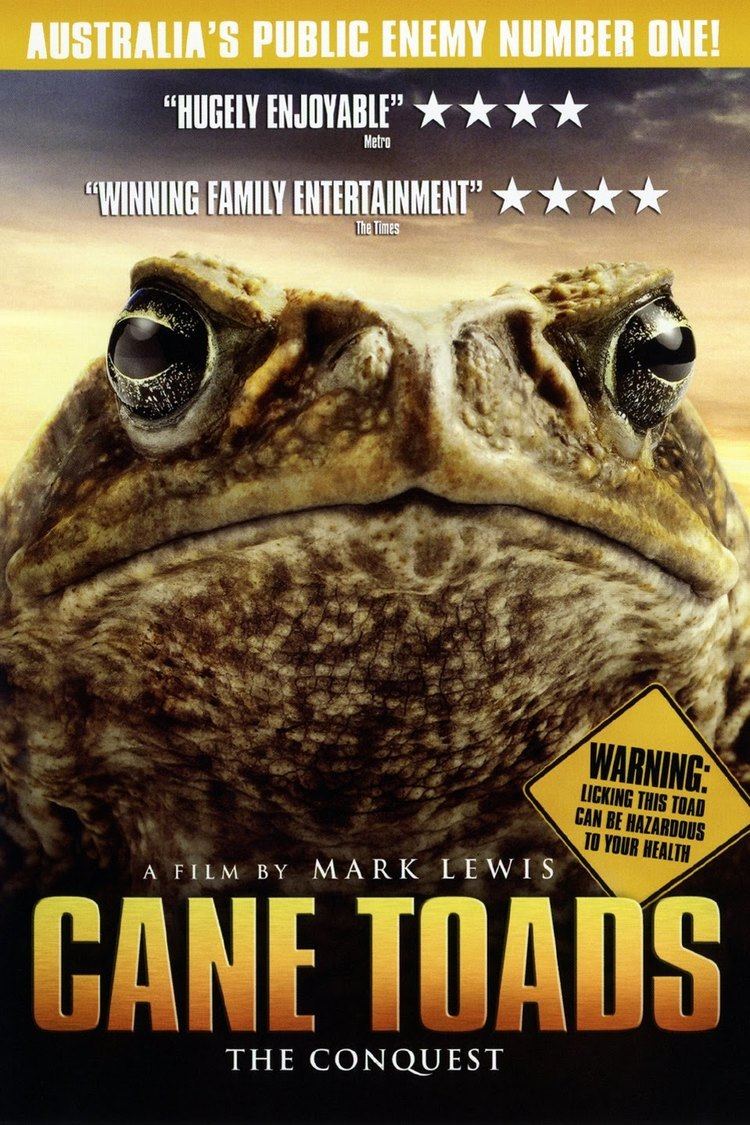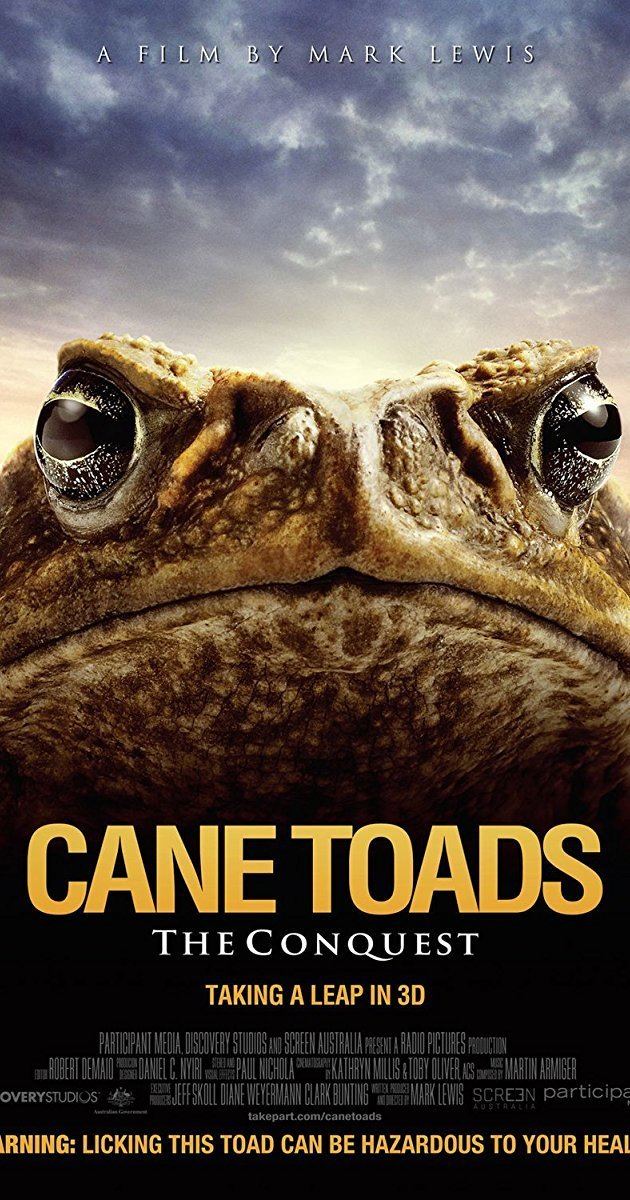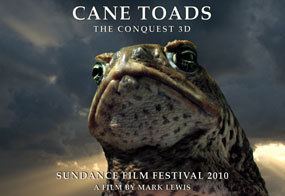Cane Toads: The Conquest
8 /10 1 Votes8
Duration Language English | ||||||||||||||||||||||||||||||||||
 | ||||||||||||||||||||||||||||||||||
Release date 2011 | ||||||||||||||||||||||||||||||||||
Cane toads the conquest official trailer
Cane Toads: The Conquest, a 2010 documentary film by Mark Lewis, tracks the inexorable decades long march of the invasive cane toad across Australia, a "sequel of sorts" to his 1988 cult classic, Cane Toads: An Unnatural History. It is described as an "irreverent" blend of "history, nature footage, re-enactments and colorful testimony," documenting what is widely considered to be one of Australia's biggest environmental disasters through its effect on people. It was filmed in 3D.
Contents
- Cane toads the conquest official trailer
- Cane toads the conquest unofficial trailer
- Plot
- Production
- Reception
- Historical significance
- References

Cane toads the conquest unofficial trailer
Plot

The film combines old newsreels, nature footage featuring cane toads in action, re-enactments of toad-related events, and the first-hand accounts of people's interactions with the toads. The story begins with the toads in full form 15 million years ago, and fast-forwards to the 1935 introduction of 102 cane toads to Australia in an ill-conceived attempt to take on the cane beetle devastating sugarcane crops. The toads' proliferation got out of hand, and they became a seriously invasive species, marching across Australia, capturing huge swathes of territory over the decades. Various characters, including scientists, farmers, and everyday people, provide testimony about the creatures.
Production
The film was produced by Mark Lewis' independent Radio Pictures, based in Mullumbimby, Australia, in partnership with Americans Participant Media and Discovery Studios. It was shot in 3D with Silicon Imaging cameras.
Reception

According to Box Office Mojo, the film has brought in under $100,000. At review site Rotten Tomatoes, the film scored 88% on the Tomatometer, a critic aggregate rating based on 16 reviews.
Historical significance

When looking at the evolution of the wildlife filmmaking genre, Lewis' films take an interesting position. According to Cynthia Chris, the wildlife film genre takes its roots in the imperialism and colonialism of the nineteenth century. Starting as expedition travelogues and hunting newsreels, they then became popular for their sentimental value. In the 1940s, they projected the ideological values of progress, individualism, and family. By the end of the twentieth century, the genre became more prestigious, educating while entertaining, and appealing to a middle class audience. Today, as Derek Bousé points out, two different categories of wildlife films can be distinguished: low-budget environmental documentaries and high-budget blue chip films. Lewis joins the two categories by dealing with an environmental issue in a high-production value blue-chip film. Moreover, it brings back to the front page the themes of colonialism and colonization that were originally the root of wildlife filmmaking.
Lewis' Cane Toads has several additional revolutionary elements. Bousé suggests that nature has become a resource for art and entertainment today. Mitman denounces films that exploit nature and make it a spectacle, ignoring the inevitable nature-human relationship. However, Lewis succeeds in creating a film that acknowledges this interaction and important relationship. Cane Toads is a reversal of the man vs nature relationship that characterizes most wildlife films. It is a study of human nature through the eyes of cane toads. Humans become the source of entertainment.
Unlike blue-chip films that use charismatic, cute, or large and loved animals in their movies, Lewis chooses small, ugly, and often hated creatures as his characters. McKibben points out that in wildlife films humans are generally the center of attention and nature is secondary. Lewis goes against this problem in his film by making the toad the protagonist and the hero defeating the man. Moreover, McKibben criticizes wildlife films that are misleading to the viewer because they show animals so often on the screen that they seem numerous. Ironically, in Cane Toads the toads are everywhere and cannot be exterminated.
The small creatures are clearly superior to humans and spreading over the country regardless of the eradication efforts taken against them. The viewer is witnessing first-hand the limitations of humans towards the forces of nature. As Anthony Carew puts it, Lewis' films feature "a parade of off-beat anecdotes in which animals and men cross paths and man comes off second-best." Through humor, Lewis despises mankind's greed for power, control, and in turn the inevitable destructive impact of humans on the natural world.
Lewis' film is also unconventional in that it does not use a narrator, a host, nor a main character to lead the story. Instead the film is a compilation of interviews with carefully chosen characters who have strong and often opposing views on a situation. It gives us a detailed historical account on a conservation issue, with specific scientific facts. However, through the choice of his characters, his original cinematographic style, and the use of humor, the viewer becomes fascinated by those potentially dry facts.
Dawson points out that the impact of the toads on the ecosystem is lacking in the film. The focus of the story is more on the interactions between humans and toads, and the environmental relationship is missing. Nevertheless, the film is accompanied by a book by Karl Weber about cane toads, the impact of invasive species on the environment, and what steps can be taken to prevent or remedy those negative consequences. Thus, Cane Toads has more of an environmental purpose than most of the wildlife films designed solely for entertainment.
